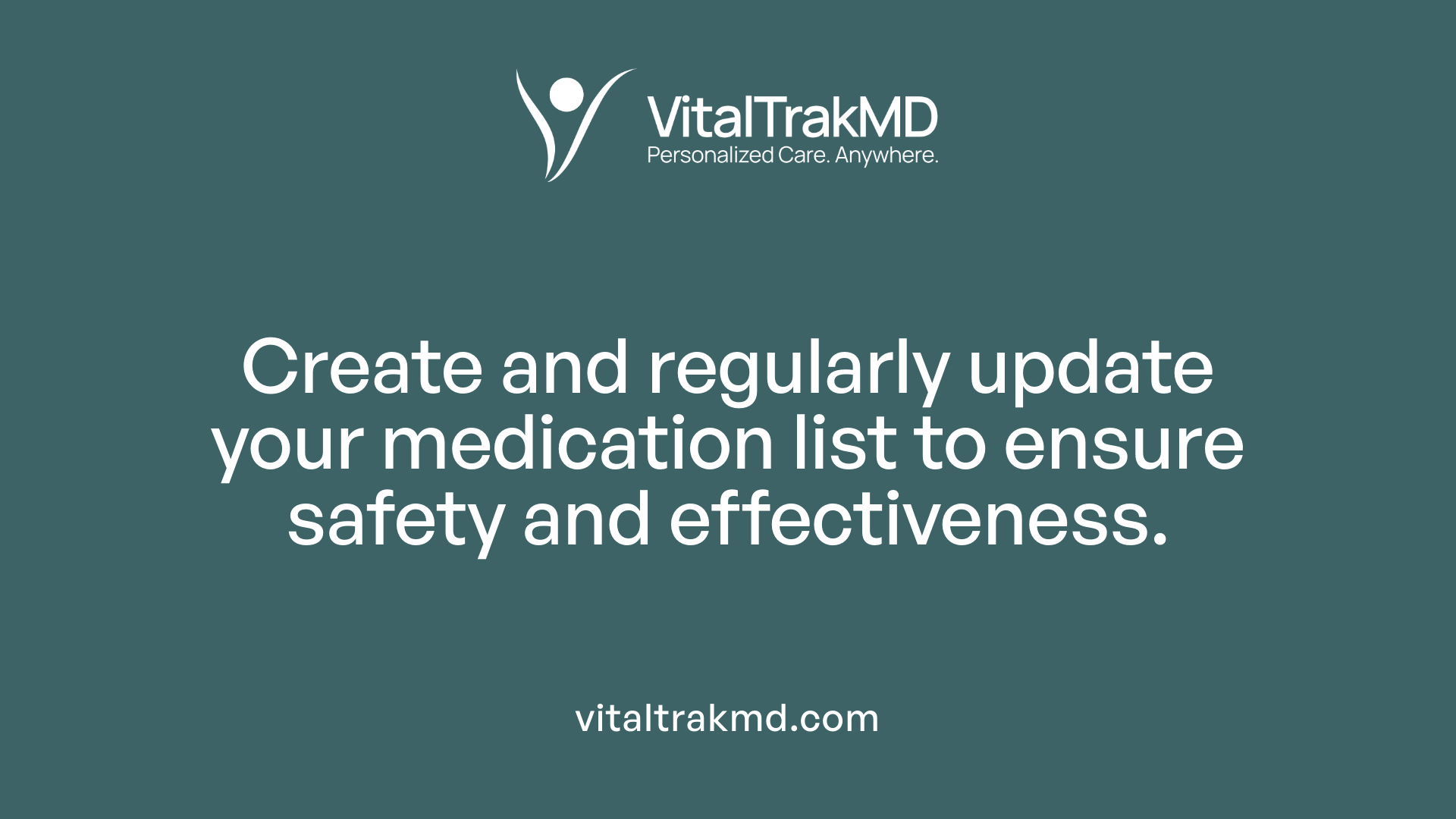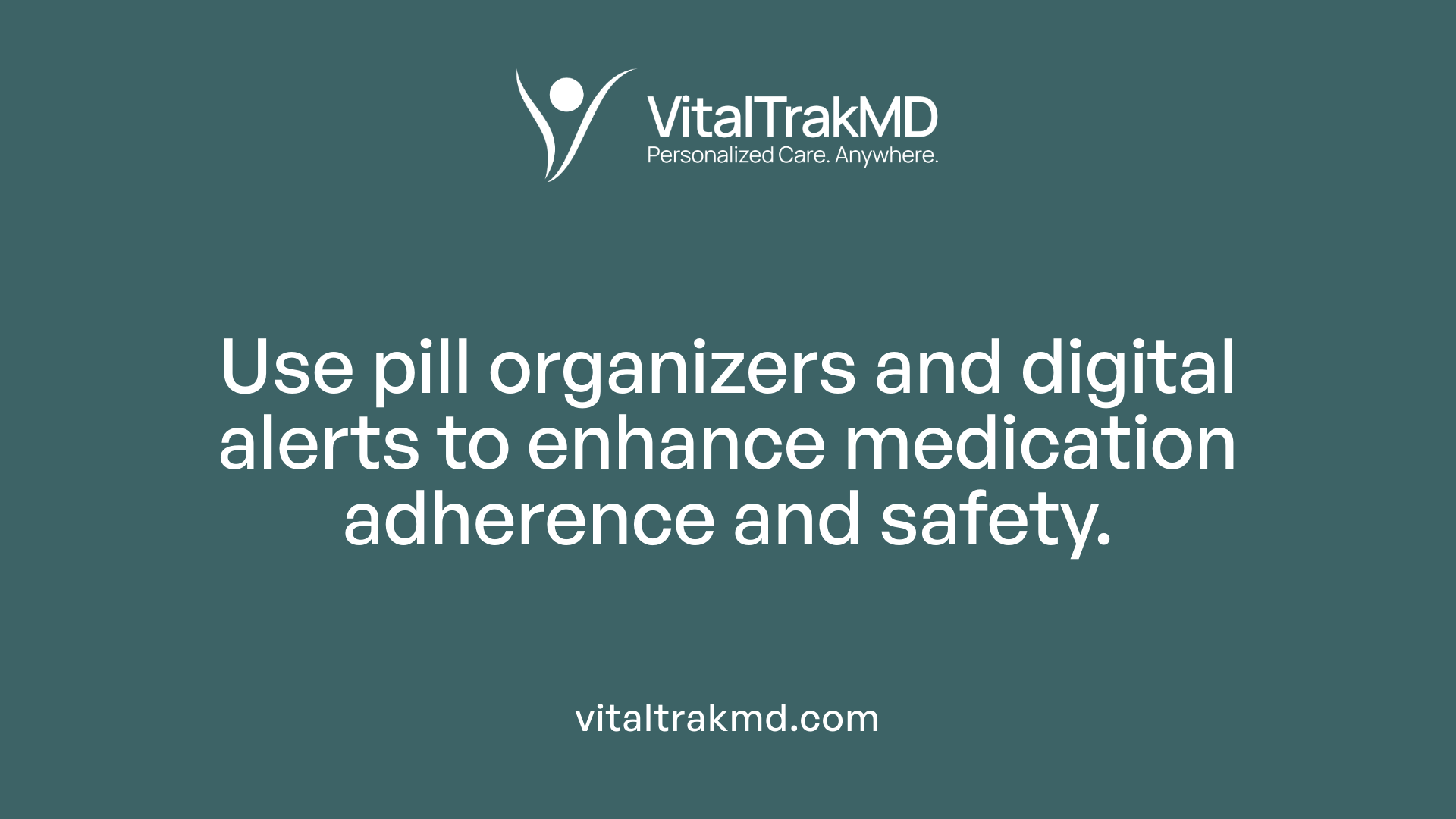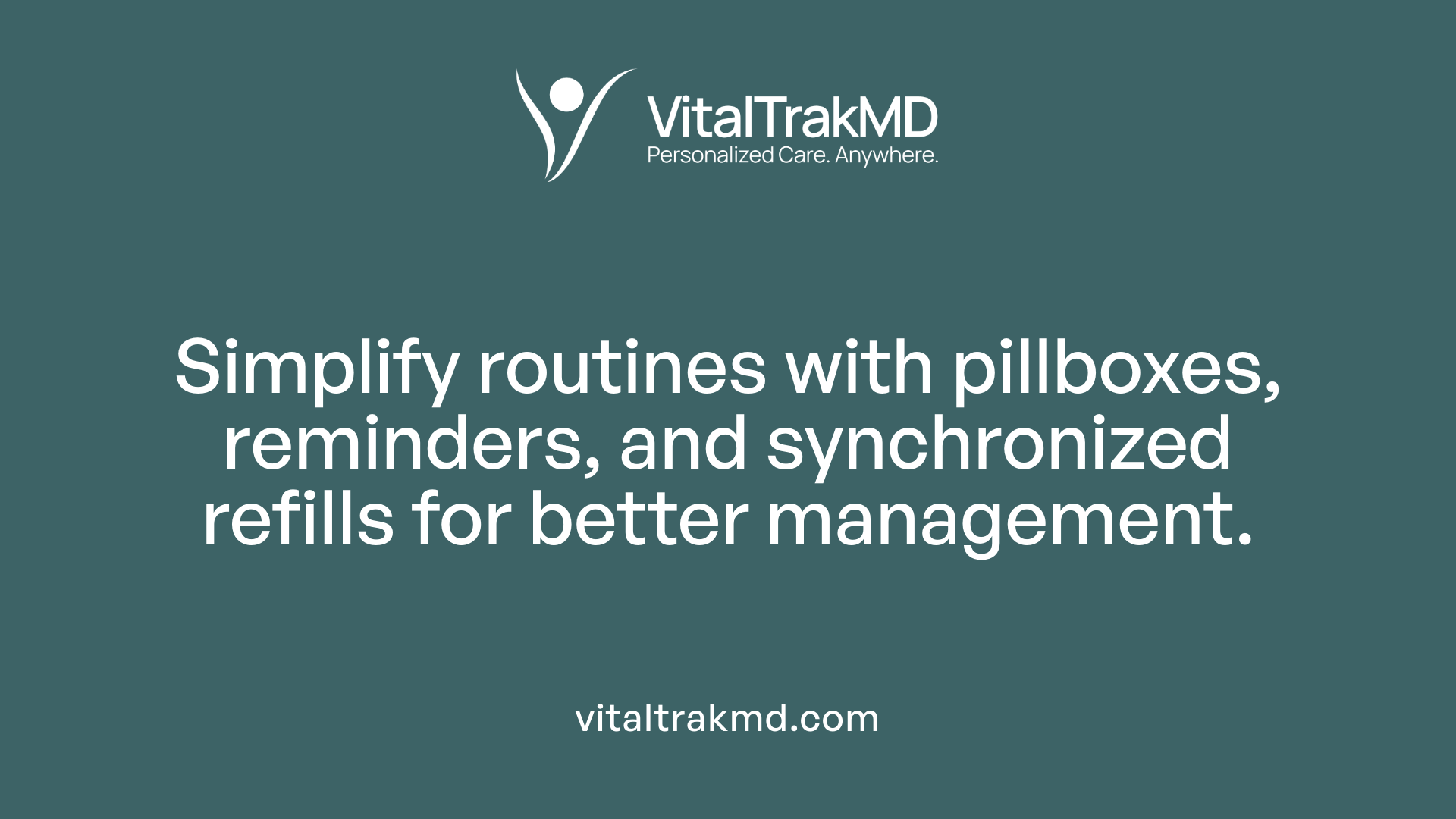Managing Multiple Medications: Tips for Aging Adults and Caregivers

Understanding the complexities of medication management in older adults
Managing multiple medications in aging adults is a critical aspect of healthcare that requires careful planning, organization, and collaboration. As the population ages and the prevalence of chronic conditions increases, so does the complexity of medication regimens. This article explores effective strategies to enhance medication safety, improve adherence, and prevent healthcare problems related to polypharmacy, offering practical tips for older adults and their caregivers.
Developing a Comprehensive Medication Management Plan
 Creating a detailed medication list is a fundamental step in effective medication management for older adults. This list should include the names of all medications, their dosages, prescribed times, administration instructions, and the healthcare providers who prescribe them. Keeping this list updated regularly ensures that any changes in medication regimens are accurately reflected.
Creating a detailed medication list is a fundamental step in effective medication management for older adults. This list should include the names of all medications, their dosages, prescribed times, administration instructions, and the healthcare providers who prescribe them. Keeping this list updated regularly ensures that any changes in medication regimens are accurately reflected.
Regular review and updating of medication lists help prevent errors such as incorrect dosing, accidental duplications, or missed medications. It’s important to confirm all medication details with healthcare professionals like doctors and pharmacists to ensure safety and appropriateness.
Communicating any modifications in medication plans to all involved healthcare providers is crucial for continuity of care. Carrying a copy of this list or a wallet card during doctor visits and hospital stays ensures everyone is informed about current medications. Using tools like medication management apps, pill organizers, and synchronized refill schedules can aid in adherence and reduce the risk of missed doses.
Effective strategies for managing multiple medications in aging adults include comprehensive medication reviews, deprescribing unnecessary drugs, and leveraging assessment tools such as the Beers Criteria or STOPP. These tools help identify potentially inappropriate medications and facilitate safer prescribing.
Lastly, involving caregivers and ensuring they understand the medication plan can significantly improve adherence and safety. Proper storage in a cool, dry environment, disposal of expired medicines through pharmacy take-back programs, and ongoing education about medication use contribute to a well-rounded and safe medication management approach.
Utilizing Medication Organizers and Digital Reminders
 For older adults managing multiple medications, practical tools and technology can significantly enhance safety and adherence. Pill organizers are among the most effective aids, allowing individuals to sort doses into weekly or daily compartments that correspond to different times of day. These containers help prevent missed doses and reduce confusion, especially when medications need to be taken at specific intervals.
For older adults managing multiple medications, practical tools and technology can significantly enhance safety and adherence. Pill organizers are among the most effective aids, allowing individuals to sort doses into weekly or daily compartments that correspond to different times of day. These containers help prevent missed doses and reduce confusion, especially when medications need to be taken at specific intervals.
Digital tools such as medication reminder apps and calendar alerts are widely accessible options. Apps like Medisafe, for instance, provide timely notifications to take medications and can alert users about refills or interactions. Setting up these reminders on smartphones or tablets makes it easier to follow complex schedules, even when routines are busy or disrupted.
Smart devices, including smart speakers and home assistants, can be programmed to issue voice alerts or alarms. These alerts serve as additional prompts, ensuring that doses are not forgotten, especially for individuals with memory challenges. Combining these digital solutions with physical organizers offers a layered approach to medication safety.
What are the best practices for ensuring medication safety and adherence in older populations?
Ensuring medication safety and adherence in older populations requires a comprehensive, patient-centered approach that includes clear communication and individualized treatment plans. Simplifying medication regimens and utilizing management tools like medication logs can help address forgetfulness and reduce confusion. Education for both seniors and caregivers about proper medication use, potential drug interactions, and storage is essential, as well as involving healthcare professionals in ongoing monitoring. Incorporating behavioral and motivational strategies, such as shared decision-making and reminders, can enhance adherence over time. Regular assessment, support from multidisciplinary teams, and access to reliable educational resources further contribute to safe and effective medication management in older adults.
Organizing and Synchronizing Medication Routines
 To help older adults manage their medications effectively, various strategies can be employed to ensure safety and consistency.
To help older adults manage their medications effectively, various strategies can be employed to ensure safety and consistency.
Using pillboxes with multiple compartments is a practical way to organize medications. These containers typically have sections labeled for different times of the day or days of the week, making it easier to track doses and prevent missed or double doses.
Set reminders and alarms through smartphones, smart speakers, or specialized apps. These tools can alert users when it’s time to take medications, reducing forgetfulness and encouraging adherence.
Maintaining a detailed medication list is essential. This list should include medication names, dosages, routes of administration, frequency, purpose, prescribing doctors, and any side effects experienced. Carrying a copy or digital version helps inform all healthcare providers involved.
Pharmacy services like medication synchronization significantly simplify medication routines. This approach aligns refills so all prescriptions are renewed on the same day each month, making it easier to keep track and reducing the number of trips to the pharmacy.
Together, these methods foster better medication management, minimize errors, and help maintain health and safety for aging individuals.
The Role of Healthcare Professionals in Ensuring Medication Safety

How can working with healthcare professionals, such as pharmacists, improve medication safety for older adults?
Collaborating with healthcare providers, especially pharmacists, plays a vital role in promoting safe medication practices among older adults. Pharmacists conduct thorough medication reviews to identify unnecessary drugs, potential drug interactions, and duplications, improving the overall safety of medication regimens.
They also assist in medication reconciliation during care transitions, ensuring that all medications are up-to-date and appropriate. This process helps prevent errors and adverse effects that may occur when patients switch between doctors or care settings.
Patient education is another crucial aspect. Pharmacists offer guidance on how to correctly take medications, explain potential side effects, and discuss interactions with foods, herbal supplements, or other drugs. This education enhances adherence and decreases the likelihood of mistakes.
Furthermore, pharmacists support deprescribing efforts—reducing or stopping medications that are no longer necessary or that pose risks—by working closely with physicians. They help tailor treatments to match the person’s specific health conditions and risks, avoiding polypharmacy complications such as falls, confusion, or hospitalizations.
Modern tools like electronic health records and medication management systems enable pharmacists to provide these comprehensive services effectively. Legislative policies and institutional protocols also empower pharmacists to take an active role in medication safety.
Overall, interdisciplinary teamwork, continuous patient education, and systemic support are essential strategies. They ensure that older adults receive the most appropriate, safe, and effective medication regimens, ultimately enhancing their health outcomes and quality of life.
Addressing Risks and Challenges of Polypharmacy

What are the common risks and challenges associated with polypharmacy in older adults, and how can they be addressed?
Polypharmacy, or the use of multiple medications, is common among older adults, especially those with chronic conditions. While medications can improve health and quality of life, taking many drugs also raises significant risks. Adverse drug reactions (ADRs), harmful drug interactions, and prescribing cascades—where side effects are mistaken for new symptoms and mistaken medications are added—are frequent concerns.
These risks can lead to serious health issues such as falls, confusion, hospitalization, and even increased mortality. Older adults often experience physiological changes that affect how their bodies process medications, including decreased kidney and liver function, altered drug absorption, and changes in body composition. These factors can cause drugs to stay in the system longer, heightening side effect risks.
To address these challenges, healthcare providers recommend regular medication reviews using specific tools like the Beers Criteria and STOPP/START guidelines. These assessments help identify potentially inappropriate or unnecessary medications that can be deprescribed. A team approach involving pharmacists, doctors, and caregivers ensures comprehensive care.
Engaging patients in shared decision-making and educating them about their medications is crucial. Transparent communication helps reduce resistance to stopping or adjusting drugs.
Technological solutions like electronic health records (EHRs), decision support software, and specialized policies can further improve medication management. These measures work together to minimize errors, reduce unnecessary medications, and ultimately protect older adults from avoidable adverse outcomes.
By systematically addressing polypharmacy risks, health care teams can improve safety, reduce hospitalizations, and enhance the overall well-being of aging patients.
Implementing Systematic Deprescribing and Monitoring
How can healthcare providers reduce medication-related problems among older adults?
Deprescribing is a careful process that involves systematically reviewing a patient's medications to identify and stop drugs that may no longer be necessary or might be causing harm. This approach helps reduce issues like adverse drug reactions, interactions, and polypharmacy, which are common among older adults.
To guide this process, clinicians employ various assessment tools. The NO TEARS assessment, the Hyperpharmacotherapy Assessment Tool, the Beers Criteria, and STOPP criteria are widely used to pinpoint high-risk medications and identify those that may be inappropriate. These tools provide evidence-based recommendations to facilitate safe medication discontinuation.
The deprescribing process should follow a stepwise approach. Initially, clinicians review all current medications, consider the patient's overall health, and prioritize drugs for potential withdrawal. This is followed by gradually tapering or ceasing medications while closely monitoring the patient for withdrawal effects or re-emergence of health issues. Regular follow-up visits enable healthcare providers to assess the patient’s response and adjust plans accordingly.
Effective deprescribing also involves clear communication and shared decision-making with patients and caregivers. Explaining the reasons for stopping certain medications, discussing potential side effects, and documenting all changes are vital steps in ensuring safety and compliance.
By implementing these strategies, healthcare providers can significantly decrease medication-related problems, enhance medication safety, and improve overall health outcomes for older adults.
Supporting Safe and Collaborative Medication Management
In conclusion, managing multiple medications effectively in older adults is a multifaceted process that hinges on thorough planning, organization, and teamwork. Utilizing tools like comprehensive medication lists, pill organizers, and digital reminders helps caregivers and seniors stay on track. Regular medication reviews, guided by clinical tools and facilitated by collaboration with healthcare professionals—including pharmacists—are vital in reducing the risks associated with polypharmacy. Addressing challenges such as physiological changes, medication interactions, and adherence barriers requires proactive strategies like deprescribing, education, and systemic support. By fostering open communication, maintaining safety protocols, and empowering older adults and their caregivers, healthcare providers can ensure safer medication practices, enhance quality of life, and prevent avoidable complications.
References
- Medication Management at Home: Tips for Seniors and ...
- Managing medications for aging parents
- Medication Management and Safety Tips
- Caregiverʼs Guide to Medications and Aging
- Strategies to Reduce Polypharmacy in Older Adults
- A Caregiver's Guide to Medication Management
- Medication Management | Department of Aging
Recent articles
Want to Feel Better and Live Healthier?
Join hundreds of patients taking control of their health with personalized care that fits their life – not the other way around.
Rated 4.8/5 by 32+ customers







